Four years and one day after President Obama first took his first oath of office, America is once again celebrating his Inauguration. This time the schedule includes performances by Beyonce and Katy Perry, a parade with more than 2,000 members of the military and two Inaugural balls.
Refresh here for updates throughout the day.
Tune in to the ABC News.com Live page on Monday morning starting at 9:30 a.m. EST for all-day live streaming video coverage of Inauguration 2013: Barack Obama. Live coverage will also be available on the ABC News iPad App and mobile devices.
Read Obama’s second Inaugural address here.
All times are in Eastern Standard Time.
9:22 p.m. – Photo: Obama and Michelle’s First (Second Inaugural) Dance
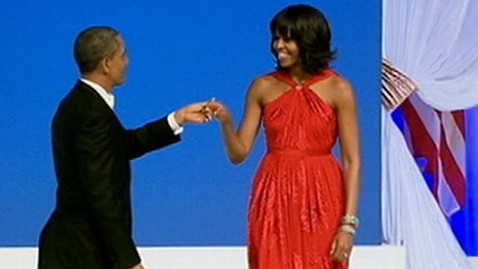
President Barack Obama and First Lady Michelle Obama dance together at the Walter E. Washington Convention Center, Jan. 21, 2013, in Washington, DC. (Jewel Samad/AFP/Getty Images)
9:06 p.m. – Michelle’s Dress
ABC’s Mary Bruce reports:
The First Lady is wearing a custom Jason Wu ruby colored chiffon and velvet gown with a handmade diamond embellished ring by jewelry designer Kimberly McDonald. She is wearing shoes designed by Jimmy Choo. At the end of the Inaugural festivities, the outfit and accompanying accessories will go to the National Archives.
The President and First Lady are dancing to Al Green’s “Let’s Stay Together,” performed by Jennifer Hudson.
The Vice President and Dr. Biden will dance to Ray Charles’ “I Can’t Stop Loving You,” performed by Jamie Foxx.
Hudson and Foxx will perform the first dance song at each of the first and second families’ stops – in the Ballroom for the Commander-in-Chief’s Ball and on both floors of The Inaugural Ball.
9:00 p.m – Obama Thanks Soldiers at Commander in Chief’s Ball
The president and Michelle Obama made their first stop of the night at the Commander in Chief’s ball, where President Obama thanked military servicemembers in the audience as he spoke.
“I have no greater honor than being your commander in chief. It’s because of you that with honor we were able to end the war in Iraq, because of you that we delivered justice to Osama bin Laden, because of you that it’s even possible to give Afghans a chance to determine their own destiny,” Obama said.
A TV screen to Obama’s right showed soldiers stationed in Kandahar, Afghanistan. Privates and master sergeants congratulated him on his inauguration.
“Every single day we are thinking of you,” Obama told them in response. “When you get back home, you’re gonna be greeted by a grateful nation, and you’re gonna be on our minds tonight and every single night until our mission in Afghanistan is complete.”
8:32 p.m. – The Balls are Underway – Get the live stream at abcn.ws/live
6:35 p.m. – Welcome to Twitter, Michelle’s Bangs
We knew it was coming. Someone created a Twitter account called @FirstLadysBangs.
Withing hours of its entry into the world, the Twitter character had considered and shot down a run against Donald Trump’s hair in 2016.
Sound a little crazy? Blame it on super long parade fatigue.
5:42 p.m. – The Cheese Stands Alone
The ladies of the Obama clan have left the Presidential Reviewing Stand. The president remains there to watch the rest of the parade, including a group of uni-cyclists from Maine called the “Gym Dandies.”
5:28 p.m. – Obama Inauguration: Who’s Who?
Who were those people sitting behind the president this morning anyway? Click the photo below to see an infographic with a guide to Obama’s family, colleagues and dignitaries.
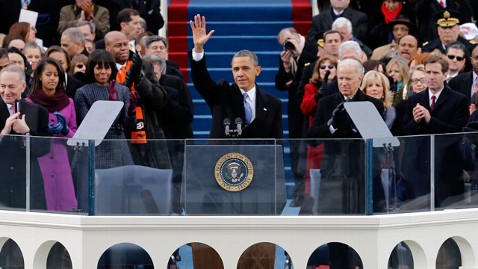
(Image Credit: Scott Andrews/AP Photo)
5:22 p.m. – Biden 2016?
Vice President Joe Biden got very friendly with members of the crowd watching the inaugural parade, prompting some to wonder if this isn’t a prelude to his own presidential run.
4:55 p.m. – POTUS on His Blackberry Before the Parade
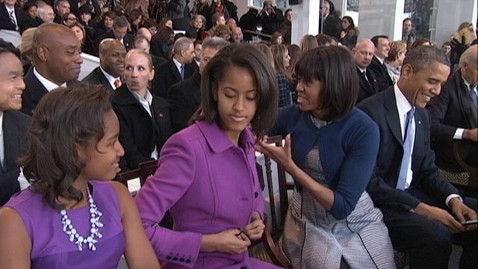
(Image Credit: Obtained by ABC News)
It may be a day-long celebration for President Obama, but that doesn’t mean he has left work at the office.
Just before members of the military began streaming by the Presidential Reviewing Stand as part of the inaugural parade, Obama could be seen working on what looks like his specially-secured Blackberry.
Beside him, Sasha and Malia whipped out their iPhones, taking photos of their mother and interrupting their father to make him pose with the first lady. The first family had removed their coats, thanks to heat inside the reviewing stand.
And it was also clear President Obama was chewing gum as he head-bobbed along to the marching bands. Today more than ever he looked like Obama: the gum-chewing, Blackberry-checking president of the people.
What’s not clear – who emails the president on inauguration day? And was it Nicorette gum?
4:30 p.m. – Wrapping Up the Route
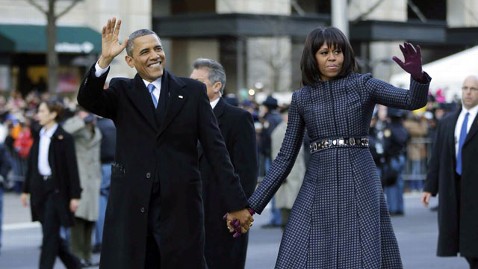
(Image Credit: Charles Dharapak/AP Photo)
ABC’s Devin Dwyer reports the President, the first lady, the Vice President and Dr. Biden will soon make their way to the reviewing stand on Pennsylvania Ave. where they will be joined by Congressional leaders, Supreme Court Justices, governors, the Joint Chiefs and White House staff as well as area elementary school students and some of the Tuskegee Airmen and their families, according to the White House.
4:00 p.m. – Obama, Roberts Sign King Bible
ABC’s Avery Miller reports President Obama and Supreme Court Chief Justice John Roberts signed Martin Luther King, Jr.’s Bible today, at the request of the family.
In his life time, it was King’s “traveling Bible,” according to the Presidential Inaugural Committee.
“An avid reader who was constantly on the road, Dr. King typically traveled with a selection of books that included this Bible,” the PIC wrote in a statement about the Bible written when they announced Obama would use it in his ceremony. “It was used for inspiration and preparing sermons and speeches, including during Dr. King’s time as pastor of Dexter Avenue Baptist Church in Montgomery, Alabama.”
Read more about President Obama’s choice of Bibles here.
3:56 p.m. – Justice Scalia and the Mystery of the Funny Hat
Michelle Obama wasn’t the only one drawing eyes with her fashion choices at the inaugural ceremonies today. Many on Twitter – including Sen. Claire McCaskill, D-Mo., – remarked on Associate Justice Antonin Scalia’s choice of headgear during President Obama’s swearing-in.
Some compared it to Aretha Franklin’s extravagant hat at the 2009 inauguration. Others simply wondered where it came from.
To find that answer, ABC’s Sarah Parnass spoke with Scalia’s former clerk, Kevin Walsh.
Walsh, who now teaches at University of Richmond School of Law, said the association of Catholic lawyers to which he belongs, St. Thomas More Society of Richmond Va., presented Scalia with the hat in 2010.
The hat is a replica of one worn by St. Thomas More in his most iconic portrait, done by Hans Holbein, according to Walsh.
When giving Justice Scalia the hat, the members of the St. Thomas More Society thought it would be a nice memento. “If nothing else it would be suitable for university functions,” Scalia said.
Walsh said the significance of Scalia’s wearing the hat likely doesn’t go beyond function. In the past, Scalia has worn a skull cap, much like the one Justice Breyer sported today. But the skull cap doesn’t have earflaps – the More hat does.
“That one’s warmer,” Walsh said, comparing the hat Scalia wore today with the one he wore to the 2009 inauguration. “I’d say it’s more functional.”
ABC’s Bob Murphy adds this historical background:
Thomas More was the Lord Chancellor or Chief Legal Officer of England when Henry VIII was King. He famously lost his head (the one the hat was made for) rather than reinterpret the laws of divorce and allow the King to dispatch his Queen. He is a hero to the Catholic legal community for his commitment to moral and legal authority over the whim of the chief temporal power.
The ultraconservative Catholic jurist may or may not be making a statement but the significance is interesting.
3:39 p.m. – Inauguration Day in Pictures
Click the picture below for a slideshow of some of the 2013 inauguration’s most memorable moments so far.

(Image Credit: Jonathan Ernst-Pool/AP Photo)
3:33 p.m. – Obama Pauses for Final Glimpse of Fans
ABC’s Devin Dwyer reports:
After a bruising campaign, and unusually contentious post-election period, President Obama savored his second and final Inauguration Day as a brief respite from political storms and celebratory moment for his hundreds of thousands of adoring supporters.
As he walked off the inaugural platform on the west front of the U.S. Capitol, Obama turned and paused to look out at the crowd on the National Mall, even as his family and other guests continued ahead without him.
“I want to take a look one more time,” Obama was heard saying. “I’m not going to see this again.”
Read more on that poignant moment with the president here.
3:22 p.m. – Obama Makes History Citing Gay Rights in Inaugural Address
ABC’s Shushannah Walshe reports:
President Obama made history in his inaugural address today mentioning the word “gay” and the issue of gay rights for the first time in a speech at the presidential swearing in.
“Our journey is not complete until our gay brothers and sisters are treated like anyone else under the law for if we are truly created equal, then surely the love we commit to one another must be equal as well,” Obama said in his address on the Capitol steps after his swearing in.
Obama also mentioned the word Stonewall when citing milestones of the civil right struggle. It was a reference to a riot and subsequent protests over a police raid in June 1969 of the Stonewall Inn, a gay bar in New York City’s Greenwich Village. The president mentioned it along with the first women’s rights convention held in Seneca Falls, N.Y., in 1848 and the civil rights march in Selma, Ala., in 1965.
“We, the people, declare today that the most evident of truths – that all of us are created equal – is the star that guides us still; just as it guided our forebears through Seneca Falls, and Selma, and Stonewall,” Obama said.
Brian Ellner who led the successful campaign to make same sex marriage legal in New York state called the speech “historic.”
Read more from Walshe here.
Back to top
3:12 p.m. – Obama Sticks to His Script in Second Inaugural Address
ABC News’ Michael Falcone reports:
By their very nature, the texts of presidential inaugural addresses become historical documents as soon as they are delivered. Obama’s speech, like all the others before, will be scrutinized for years to come.
So, how closely did President Obama, who is known for his oratorical prowess, hew to the prepared text of his remarks? With the exception of a few minor words,
It turns out he stuck almost exactly to the script.
“We must harness new ideas and technology” became “So we must harness…” and “Let each of us now embrace, with solemn duty and awesome joy, what is our lasting birthright” ended up as “Let us, each of us, now embrace…” He sprinkled in an extra “and” at the beginning of one paragraph and turned a “that is” into “that’s.”
Otherwise, the president delivered the speech he had in front of him with almost no changes.
Back to top
2:26 p.m. – Tell the President What You Want
Whether you voted for him or not, tell President Obama what you’d most like to see him tackle in his second term and why.
Upload a video or photo, or send your comments telling the president what is most important to you in the next four years.
The best submissions may be featured today on ABCNews.com.
Click the photo below to see how you can participate.

(Image Credit: ABC News Photo Illustration)
Back to top
2:11 p.m. – Obama Address References Civil Rights, Gay Marriage, Immigration
Univision’s Jordan Fabian reports:
Obama, the nation’s first black president, delivered his address on Martin Luther King, Jr. Day and drew strong parallels between the civil rights battles of King’s generation to the social issues facing today. Perhaps most notable was Obama’s reference to gay rights, believed to be a first for a presidential inaugural address.
“Our journey is not complete until our gay brothers and sisters are treated like anyone else under the law,” he said. “For if we are truly created equal, then surely the love we commit to one another must be equal as well.”
The president also made a forceful statement in support of comprehensive immigration reform, a campaign pledge from 2008 that remains unfulfilled. Obama has repeatedly pledged to make it one of his top legislative priorities this year.
“Our journey is not complete until we find a better way to welcome the striving, hopeful immigrants who still see America as a land of opportunity; until bright young students and engineers are enlisted in our workforce rather than expelled from our country,” he said.
Read more from Fabian here.
Back to top
2:05 p.m. – Obama’s Inaugural Declaration: ‘Our Time’ for Changing Nation

(Image Credit: Win McNamee/AP Photo)
Analysis by ABC’s Rick Klein:
President Obama used a brief pause in the partisan warfare that’s scarred his time in office to return to the ideals of the Declaration of Independence, with his own declaration of urgency and a call to action that reflects shared sacrifice and responsibility.
This was no centrist conciliator. It was the speech of a committed, unapologetic progressive, an Obama doctrine for domestic policy that included concrete commitments in areas he made little progress on over his first four years. Above all, he was speaking to a changing America – the nation that propelled him to a second term, and whose voices he will need to channel to be effective over the next four years.
“My fellow Americans, we are made for this moment, and we will seize it – so long as we seize it together,” the president declared.
Read more on what Obama meant and what opportunities he sees going forward here.
1:30 p.m. – More on Inaugural Poet Richard Blanco
Univision’s Jordan Fabian reports:
There has not been another inaugural poet like Richard Blanco.
Out of the five people selected to read an original poem at a presidential inauguration, the 44-year-old Blanco is the first Latino, first gay man, and youngest person to serve the role. The presidential inaugural committee officially announced the choice of Blanco, the son of Cuban exiles, last Wednesday.
Read more from Fabian here.
Blanco wrote the poem he read, called “One Today,” in the past 11 days. It included several references to America’s workers, including the following:
One sky: since the Appalachians and Sierras claimed
their majesty, and the Mississippi and Colorado worked
their way to the sea. Thank the work of our hands:
weaving steel into bridges, finishing one more report
for the boss on time, stitching another wound
or uniform, the first brush stroke on a portrait,
or the last floor on the Freedom Tower
jutting into a sky that yields to our resilience.
Read the full poem here.
Back to top
1:24 p.m. – Sen. McCaskill Calls Out SCOTUS Hats
1:24 p.m. – Terry Moran: Inauguration Fits ‘Next America’
In response to remarks about Obama’s reference to gay marriage, Nightline’s Terry Moran analyzes the firsts of this inauguration:
Has Spanish been spoken before? Has there ever been a bigger crowd for a second inaugural?
To me, Obama’s speech, this crowd, the whole program, seemed deliberately designed to confirm the “next America”–younger, more diverse, more non-native, socially liberal–as the source of authority, even legitimacy in the nation going forward.
That’s what the election was really about, deep down. And the feeling out here seems more than the usual inaugural victory lap of the party in power. It seems cultural–and historic. It’s their moment. And so is tomorrow–not in a partisan sense. In a factual one.
Back to top
1:14 p.m. – Inaugural Performances
Kelly Clarkson, James Taylor and Beyonce sang during the inaugural ceremonies this year.
Back to top
1:09 p.m. – What’s On the Menu?
President Obama now joins members of Congress and the Supreme Court for the inaugural luncheon.
ABC’s Devin Dwyer reports the inaugural luncheon menu from the JCC:
First Course: Steamed lobster with New England chowder
Wine: Anthony Road Winery, Fox Run Vineyards & Newt Red Cellars, Tierce 2010 Dry Riesling, Finger Lakes, N.Y.
Second Course: Hickory grilled bison with wild huckleberry reduction and red potato horseradish cake
Wine: Bedell Cellars, 2009 Merlot, North Fork, Long Island, N.Y.
Third Course: Hudson Valley apple pie, sour cream ice cream, aged cheese and honey
Wine: Korbel Natural, Special Inaugural Cuvée Champagne, Calif.
NOTE the New York food/wine: Water in the holding rooms is to be Saratoga Springs (a NY label), per a PIC official. And the wines to be served at the inaugural luncheon are from New York vineyards —- all thanks to NY Sen. Chuck Schumer, who chairs the Joint Congressional Committee on Inaugural Ceremonies
Back to top
12:46 p.m. – Timing Is Everything: Chris Christie Makes Announcements Minutes Before Obama’s Speech
ABC News’ Michael Falcone reports:
During the very same hour of President Obama’s second inauguration, New Jersey Gov. Chris Christie, who is often mentioned as a potential 2016 Republican presidential contender, sent out two separate announcements.
The first from his gubernatorial campaign: “Governor Chris Christie will be visiting the Hilton Newark Airport on Tuesday morning to accept the second major endorsement of his campaign.” (The campaign did not provide information about who will be endorsing him). And the second, a statement commemorating Dr. Martin Luther King, Jr. Day. (Christie, who praised President Obama’s efforts in the wake of Hurricane Sandy, which devastated portions of coastal New Jersey, did not mention the president’s inauguration):
“Dr. King was the paradigm of strength in triumphing over adversity and racial injustice to achieve what seemed impossible to so many for so long. His legacy stands as an eternal reminder of his sacrifice and the progress he achieved and which we are obliged to protect for every citizen of our state and nation. I join New Jerseyans in honoring Dr. King’s life and work and his uncompromising commitment to peacefully working toward freedom and equality for all Americans,” Christie said in the statement.
Back to top
12:16 p.m. – Richard Blanco Delivers Inauguration Poem
Back to top
12:09 p.m. – Obama Gives Shout Out to Same-Sex Couples in Inaugural Address
In his inaugural address today, President Obama called for treating same-sex couples equal under the law. ABC News’ Arlette Saenz reports:
Of the group of 215 members in the Lesbian and Gay Band Association marching in the inaugural parade, four couples are legally married.
Leslie Becker and Lindsay Famula of Hackensack, N.J., met when Famula joined the band in 2006, and the two women, who are both percussionists, were married in May.
“It’s validation. The fact that we have been denied this right for so long when really all we want to do is be seen in the government as a couple means a lot,” Becker said. “‘Don’t ask, don’t tell’ was repealed. We’re making big advancements in civil rights for gay couples, and it means a big deal to be one of the few married couples to march in this parade.”
New Jersey has allowed civil unions since 2006, but New Jersey Gov. Chris Christie vetoed a same-sex marriage bill in February.
Becker played at President Bill Clinton’s inauguration in 1997, but the LGBA only played on the side of the parade. During President Obama’s first inauguration in 2009, the LGBA, including Becker, marched in the actual parade.
Back to top
11:56 a.m. – Hundreds of Thousands Turn Out for Inauguration
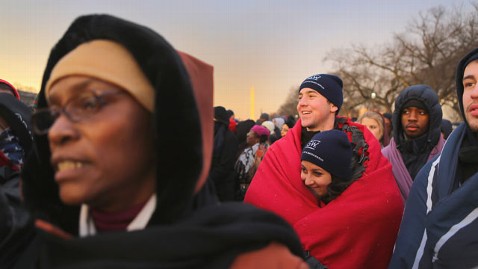
(Image Credit: Joe Raedle/Getty Images)
As of 11:00 a.m., Washington Metro Area Transit Authority reported 308,000 people used their rail service this morning. Metro was preparing last week for an estimated 600,000 to 800,000 people to come to D.C. for the events.
In 2009, 1.8 million people gathered to welcome in Obama’s first term.
Around 11:30 a.m., the U.S. Park Police released a statement about the crowding: “The National Mall is now full and closed. All visitors not on the Mall should proceed to the overflow area at the Washington Monument.”
11:50 a.m. – Obama Takes Oath for Fourth Time
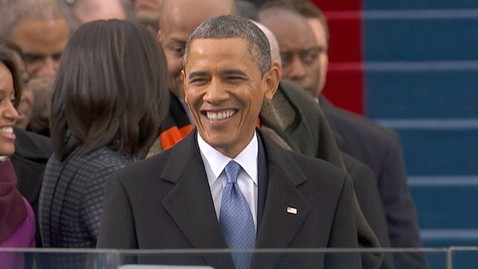
(Image Credit: ABC NEWS)
With his hand on two Bibles held by his two daughters, President Barack Obama took the inaugural oath for a fourth time. Supreme Court Chief Justice John Roberts administered the oath.
11:38 a.m. – Evers-Williams Delivers Invocation
11:33 a.m. – ABC Correspondent Tweets from Pakistan
Back to top
11:30 a.m. – Ryan Congratulates Obama
ABC’s Elizabeth Hartfield reports:
No word from Mitt Romney, but his running mate, Rep. Paul Ryan sent out a congrats to President Obama.
Ryan posted a longer congratulations on his Facebook page.
I congratulate President Obama on his inauguration, and I join the country in celebrating this American tradition.
The president and I were political opponents. We had strong disagreements over the direction of the country—as we still do now. But today, we put those disagreements aside. Today, we remember what we share in common.
We serve the same country, one that is still in need of repair—and is still the freest on earth. We serve alongside men and women from both parties, who govern in good faith and good will. Finally, we serve the same people, who have honored us with their charge.
We may disagree on matters of policy. But today we remember why we take those matters so seriously—because we seek the public good. It’s our highest duty—one that we share—and one for which we’re grateful.
I’m happy to mark this historic occasion—for the president and for the country. And I look forward to tackling the big challenges ahead.
Back to top
11:20 a.m. – A Look Back at Obama’s First Inaugural Address
ABC’s Elizabeth Hartfield reports:
As Obama’s prepares to give his second inaugural address, a look back at the first: Obama’s speech in 2009 ran 2,395 words.
According to a handy word count breakdown from the Wall Street Journal, Obama used the word “people” eight times, the word “God” five times, and the word “government” four times. We can expect that those words will pop up again in today’s speech, as the president is expected to talk about unity and finding common ground among our nation’s leaders.
A word he only uttered once in 2009, that we might expect him to bring up again more this time- “war” – as the president looks back on the drawdown of America’s military presence in Iraq, and ahead to the drawdown in Afghanistan.
Today’s speech is expected to be shorter than his speech four years ago – but by how much will remain to be seen. The high bar of second inauguration speeches is Abraham Lincoln’s address in 1965- where he managed to say a lot, in just a few words- 698 to be exact.
Back to top
11:16 a.m. – Obama Enters Arena
President Obama has entered the Capitol. Vice President Joe Biden and House Minority Leader Nancy Pelosi are close behind.
ABC’s Michael Falcone points out President Obama will be getting down to business shortly after he delivers his second inaugural address, officially submitting the names of his nominees for the posts of CIA Director, Secretary of Defense, Secretary of State and Secretary of the Treasury, according to a White House official.
Today, at the Capitol the President will be signing:
1. A Proclamation to commemorate the inauguration titled, “National Day of Hope and Resolve, 2013.”
2. Four Nominations:
a. John Owen Brennan to be Director of the CIA
b. Charles Timothy Hagel to be Secretary of Defense
c. John Forbes Kerry to be Secretary of State
d. Jacob J. Lew to be Secretary of the Treasury
ABC’s Devin Dwyer notes that four years ago, Obama signed a similar proclamation and nominations to the Senate. This occurs in the President’s Room, just off the Senate chamber, immediately following the address.
Back to top
11:15 a.m. –
Back to top
11:08 a.m. – The Biden Family Bible
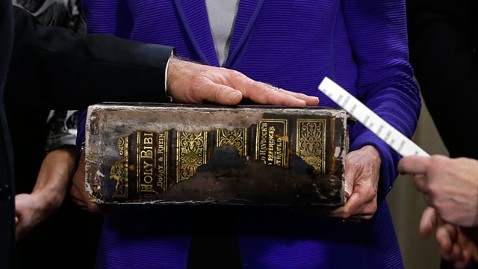
(Image Credit: Carolyn Kaster/AP Photo)
A large Bible being carried in is attracting some attention for its size. The Bible belongs to the Biden family, and it’s the one Vice President Joe Biden will use to swear his oath of office, as he did four years ago.
The 120-year-old book has a Celtic cross on the front and has been passed down through the Biden clan. It is 5 inches thick, according to the Presidential Inaugural Committee.
Biden also used it Sunday in his private swearing-in ceremony at the Naval Observatory.
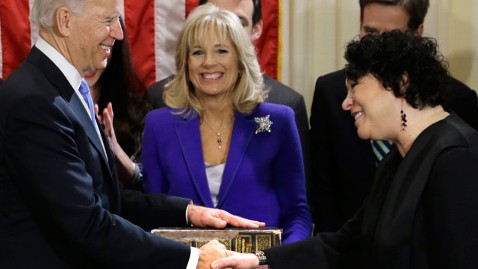
Carolyn Kaster/AP Photo
Back to top
11:04 a.m. – Powell Slams GOP’s ‘Idiot Presentations’
ABC’s Michael Falcone reports:
In an interview with ABC’s Diane Sawyer and George Stephanopoulos during ABC’s special inauguration day coverage this morning, former Secretary of State Colin Powell lashed out at people in the Republican Party who spent the last four years spreading “birther nonsense” and other “things that demonize the president,” calling on GOP leaders to denounce such talk — publicly.
“Republicans have to stop buying into things that demonize the president. I mean, why aren’t Republican leaders shouting out about all this birther nonsense and all these other things? They should speak out. This is the kind of intolerance that I’ve been talking about where these idiot presentations continue to be made and you don’t see the senior leadership of the party say, ‘No, that’s wrong.’ In fact, sometimes by not speaking out, they’re encouraging it. And the base keeps buying the stuff.
“And it’s killing the base of the party. I mean, 26 percent favorability rating for the party right now. It ought to be telling them something. So, instead of attacking me or whoever speaks like I do, look in the mirror and realize, ‘How are we going to win the next election?”
Read more from Falcone here.
Back to top
10:59 a.m. – Former President Carter Enters
Thirty-ninth President Jimmy Carter and his wife, Rosalynn, entered the Capitol to applause from the crowd. The former president shook hands and exchanged greetings with others awaiting President Obama. Carter is 88 years old and one of two former presidents expected at today’s ceremony.
The second, former President Bill Clinton, entered moments later with Sec. of State Hillary Clinton by his side.
Back to top
10:56 a.m. – How to Crash a Party
Not invited to any of the official inaugural shindigs? No sweat.
ABC’s Chris Good got the scoop on how to sneak into the festivities from Fred Karger, former 2012 Republican presidential candidate and self-proclaimed party-crasher extraordinaire.
“Karger says he has crashed an inauguration party before, plus the Oscars and Fashion Week. He has fooled rope-line workers, he says, and even the Secret Service,” Good reports.
“He twice found himself onstage at the Oscars, he says, once singing the final number alongside Liza Minnelli.”
A few of Karger’s tips: call ahead under a fake name, blend in with the entourage and don’t look back. Find all of Karger’s tips and more reporting from Chris Good here.
Back to top
10:52 a.m. – Presidential Limo: Belly of the Beast
President Obama got an upgraded presidential limo when he took office four years ago.
Pierre Thomas got an exclusive look at the unveiling back then. Take a look:
Back to top
10:41 a.m. – POTUS Departs

(Image Credit: DC Vote)
President Obama has left the White House and entered his motorcade, on the way to the Capitol.
The president’s limo is sporting special plates today, in support of the D.C. statehood movement. Read more about those plates here.
Back to top
10:39 a.m. – First Lady and Vice President on Their Way
First lady Michelle Obama left the White House, followed shortly by Vice President Joe Biden.
Back to top
10:34 a.m. – Obamas Leave White House
President Obama’s daughters, Sasha and Malia, left the White House in their pink and purple coats just a moment ago. They’re headed for the Capitol, where they will watch their father take the presidential oath for the fourth time.
They were followed minutes later by a band of Marines, then by Dr. Jill Biden, Vice President Joe Biden’s wife.
Back to top
10:31 a.m. – Events Heating Up
Members of Congress can be seen streaming into the Capitol. The inaugural pre-show began at 9:30 a.m., but Sen. Chuck Schumer, D-N.Y., won’t begin introducing the president for another hour.
Across the National Mall, attendees are waving American flags, in a sea of red, white and blue.
Back to top
10:17 a.m. – Presidential Imperfections
It’s a not-so-secret understanding that even the most well-respected president’s weren’t perfect. Turns out neither were their inaugural ceremonies.
Find the funniest and quirkiest inaugural slip ups here.
Back to top
9:58 a.m. – How Do You Spell the Event of the Day?

(Image Credit: Joanna Stern / ABC News)
ABC’s Joanna Stern reports:
Nope, it’s not inaugration. Not inaguration either. Inaugiration? Not correct. And it’s definitely not innoguration or anauguration.
Inauguration. That’s the correct spelling of the word for that big event today, at which, you know, the president officially becomes the president again.
But don’t be embarrassed if you spelled it incorrectly. It turns out it’s a pretty popular thing to do.
Over 2,500 people have tweeted about the “inaguration,” according to Topsy, which tracks tweets on Twitter. Topsy says 866 of those tweets have been in the last 30 days. “Inaugration” has been used in over 700 tweets.
Read more from Stern on the many misspellings of this historic event here.
Back to top
9:42 a.m. – Obamas on the Move
The Obama family has left church services at St. John’s Episcopal Church and headed back to the White House.
To see where the president will go next, check out ABC’s interactive map here.
Pastor Andy Stanley from the North Point Community Church in Alpharetta Georgia delivered the sermon, according to pool reports, calling the president “pastor in chief.”
This tweet from the president posted while the Obama family was still in church.
Back to top
9:15 a.m. – Obama’s View
ABC’s Jonathan Karl is on the platform at the West Front of the Capitol Building where Obama will give his inaugural address later today. He’s got the best view of the crowds, which won’t come close to the 1.8 million of four years ago, but which already number hundreds of thousands.
9:11 a.m. – Members of Congress Honor MLK on Twitter
Today America remembers the legacy of another great leader: Martin Luther King, Jr. Members of the House and Senate are taking to Twitter to express their admiration for King this morning.
9:04 a.m. – On the Ground with Good Morning America.
Back to top 9:03 a.m. – Best and Worst Inaugural Addresses

(Image Credit: Getty Images)
ABC’s Chris Good reports on the best and worst inaugural speeches of all time: Inaugural addresses, it is said, are usually not very good. Most have been long forgotten, and historians themselves point to few as memorable. It’s not entirely clear why, but the moment might have something to do with it. Book-ending divisive national campaigns, inaugural addresses offer token unity sentiments, hopefulness but not always specific hopes, and even some good ones sound myopic. “Most inaugural addresses are not remembered,” said Princeton University professor and noted presidential historian Eric Foner. “Grover Cleveland? I have no idea what he said in his.” “I have actually read every single inaugural, and it was a really boring experience,” said Robert Lehrman, a former speechwriter for vice president Al Gore, who now teaches the craft at American University in Washington. “Most of the speeches are terrible. Even the ones we remember, I don’t think there is any reporter working anywhere that couldn’t write language as crisp or concrete as the majority of them.” Read the rest of the worst and the best here. Back to top 8:56 a.m. – Outfits of the Inauguration: Obama Style ABC’s Mary Bruce reports: The President, First Lady, in a dark blue jacket, and daughters Malia, in a pink overcoat, and Sasha, in dark purple, arrived just after 8:40 a.m. at St. John’s Episcopal Church for morning services. The First Lady is wearing a navy Thom Browne coat and dress. The fabric was developed based on the style of a man’s silk tie. The belt she is wearing is from J.Crew and her earrings are designed by Cathy Waterman. She is also wearing J.Crew shoes. At the end of the Inaugural festivities, the outfit and accompanying accessories will go to the National Archives. Malia Obama is wearing a J.Crew ensemble. Sasha Obama is wearing a Kate Spade coat and dress. The Bidens arrived moments later. Back to top 8:47 a.m. – Tailor to the Presidents: Republicans Dress Better
Back to top 8:45 a.m. – Great American QuotesInaugural addresses are an opportunity for presidents on the nation’s front lawn – a place that Americans come to in turns inaugurate their leaders, protest their government and mourn their dead – to place a marker for their legacy. There have been some weighty and remarkable things said as presidents took the oath of office looking down on the Mall and also, from nearby, as other Americans have looked up and let their voices be heard at gatherings as varied as the March on Washington and the Promise Keepers. What can Barack Obama say, come Monday, as he begins a second term with lower expectations and less inspiration, to place himself on this list of great American words? Click below for an interactive look at the competition:

(Image Credit: ABC News: Ma'ayan Rosenzweig)
Back to top 8:38 a.m. – Aretha Franklin’s Hat Makes a Comeback
Back to top 8:22 a.m. – Martha Raddatz: Women Rule
Back to top
8:08 a.m. – Eva Longoria Wakes Up to with the White House
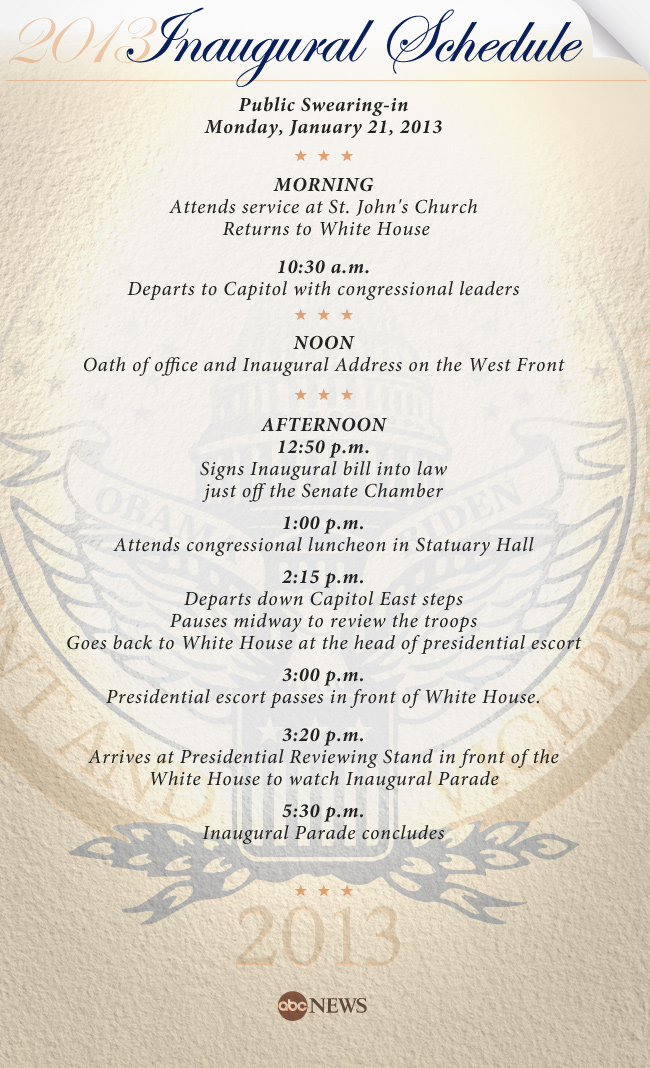
Back to top
Curated by ABC’s Z. Byron Wolf and Sarah Parnass





























